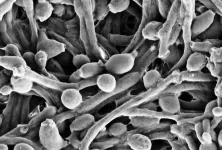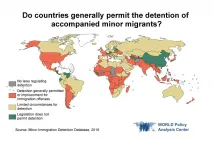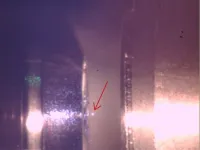Hydrogel composite developed to help protective gear rapidly degrade toxic nerve agents
2021-07-14
(Press-News.org) Scientists at Northwestern University in Evanston, Illinois have developed a hydrogel integrated with zirconium-based robust metal-organic frameworks (MOFs) that rapidly degrades organophosphate-based nerve agents used in chemical warfare. Unlike existing powdered MOF adsorbents, this hydrogel composite does not require added water and may be easily scaled up for use in protective masks or clothing. The work appears July 14 in the journal Chem Catalysis.
"Organophosphate-based nerve agents are among the most toxic chemicals known to humanity," says senior author Omar Farha, a professor of chemistry at Northwestern University. "Their use in recent global conflicts reflects the urgent need for personal protective gear, as well as the bulk destruction of chemical weapon stockpiles. In this work, we integrate MOFs and amine-containing cross-linked hydrogel into cloth to build a proper microenvironment to facilitate the fast degradation of nerve agents and supply real-time protection."
While MOFs have previously demonstrated an exceptionally fast ability to break down organophosphorus agents and chemicals that simulate them in the lab, these powdered adsorbents have proven difficult to directly integrate into protective cloths. When the nerve agents bind to their zirconium-6 clusters, they often deactivate the powder and fibrous composite catalysts. This pitfall calls for the use of alkaline solutions to regenerate the MOFs' catalytic sites--a requirement that does not prevent such MOFs from being used to eliminate stockpiled chemical weapons but which does impede their use in wearable protective gear.
To overcome this challenge, Farha and colleagues designed a MOF-based textile composite system that uses water in an amine-based hydrogel to break down nerve agents. The material works by bringing together three key components for the hydrolysis reactions that dismantle the toxic organophosphorus agents. The zirconium node of the MOF provides a Lewis acidic site that activates the phosphorus center (the active part of the nerve agent), while hydrogel pores trap the necessary water. Basic amine groups in the hydrogel backbone generate hydroxyl groups to facilitate the nucleophilic attack on the organophosphorus substrate and subsequent displacement of the hydrolysis product on the zirconium center (i.e., catalytic turnover).
The researchers integrated this hydrogel composite with cotton fibers and tested it by applying a small aliquot of either a simulant or an actual nerve agent (tested in collaboration with the US Army Lab) to its surface. Next, they analyzed the product and substrate using nuclear magnetic resonance spectroscopy. They found that the composite chemically converted 99% of the agent within just 10 minutes, maintaining this high level of catalytic activity even after it was stored in a sealed vial for 3 months.
"The composite material developed here represents a significant improvement compared to what we previously developed," says Farha. "It is also important to note that the reactivities reported here with the composite in its solid state are comparable to those obtained in alkaline aqueous solutions."
Since the authors envision the novel hydrogel composite being used as a reactive layer in suits and masks, they note that further engineering and testing will be necessary to integrate it into these existing products. However, since the method used to produce the composite is simple and easily scalable, Farha suggests that large-scale production of MOF-based masks and suits may be possible in the future.
"We are in the process of optimizing the composite material to be suitable for real-world conditions," says Farha. "We hope in the future these materials will be commercialized and used to protect human life."
INFORMATION:
This work was primarily supported by the Defense Threat Reduction Agency and the Army Research Office. Omar Farha has a financial interest in the start-up company NuMat Tech-nologies, which is seeking to commercialize metal-organic frameworks.
Chem Catalysis, Ma et al.: "Near-instantaneous catalytic hydrolysis of organophosphorus nerve agents with zirconium-based metal-organic-framework hydrogel composites" https://www.cell.com/chem-catalysis/fulltext/S2667-1093(21)00091-9
Chem Catalysis (@ChemCatalysis), published by Cell Press, is a new, monthly journal publishing innovative and insightful research on fundamental and applied catalysis, providing a platform for researchers across chemistry, chemical engineering, and related fields to disseminate and promote their work. Visit: https://www.cell.com/chem-catalysis/home. To receive Cell Press media alerts please contact press@cell.com.
ELSE PRESS RELEASES FROM THIS DATE:
2021-07-14
(Salt Lake City) - Bacteria's role in gut health has received a lot of attention in recent years. But new research led by scientists at END ...
2021-07-14
BOSTON - New research in humans and mice identifies a particular signaling molecule that can help modify inflammation and the immune system to protect against Alzheimer's disease. The work, which was led by investigators at Massachusetts General Hospital (MGH), is published in Nature.
Cognitive decline associated with Alzheimer's disease develops when neurons begin to die. "Neuron death can be caused by improper immune responses and excessive neuroinflammation--or inflammation in the brain--triggered by high levels of amyloid beta deposits and tau tangles, two hallmarks of Alzheimer's disease," explains the paper's co-senior author Filip Swirski, PhD, who conducted the work while a principal investigator in the Center for Systems Biology at MGH. ...
2021-07-14
BOSTON - Over the last decade, investigators at Beth Israel Deaconess Medical Center (BIDMC) have been at the forefront of the effort to END ...
2021-07-14
New York, NY--July 14, 2021-- A previously unknown kind of human brain cell appears to help people center themselves in their personal maps of the world, according to a new study from neuroscientists at Columbia Engineering. This discovery sheds light on the cellular mechanisms underlying navigation and memory in humans, as well as what parts of the brain might get disrupted during the kinds of memory impairments common in neurodegenerative diseases such as Alzheimer's.
There are two strategies with which humans and animals navigate and orient themselves. One involves locating places, distances and directions in "allocentric" or other-centered ...
2021-07-14
What The Study Did: The COVID-19 pandemic was associated with a decline in addiction treatment initiations but more research is needed to understand the cause of the decline in initiations and the extent to which it was due to reduced demand for services or reduced ability to supply treatment.
Authors: Tami L. Mark, Ph.D., M.B.A., of RTI International in Rockville, Maryland, is the corresponding author.
To access the embargoed study: Visit our For The Media website at this link https://media.jamanetwork.com/
(doi:10.1001/jamanetworkopen.2021.17029)
Editor's Note: The article ...
2021-07-14
What The Study Did: In this randomized clinical trial, a physician messaging campaign was effective in increasing COVID-19 knowledge, information-seeking and self-reported protective behaviors among diverse groups.
Authors: Esther Duflo, Ph.D., of the Massachusetts Institute of Technology in Cambridge, is the corresponding author.
To access the embargoed study: Visit our For The Media website at this link https://media.jamanetwork.com/
(doi:10.1001/jamanetworkopen.2021.17115)
Editor's Note: The article includes conflict of interest and funding/support disclosures. Please see the article for additional information, including other authors, author contributions and affiliations, conflict of interest and financial disclosures, and funding and support.
# # ...
2021-07-14
What The Study Did: About half the women experiencing homelessness and unstable housing who were surveyed experienced symptoms of depression or anxiety or both during the pandemic and, in addition to unmet subsistence needs and social isolation, these symptoms were associated with increased challenges accessing non-COVID-19 care and managing symptoms for chronic medical conditions.
Authors: Elise D. Riley, Ph.D., M.P.H., of the University of California, San Francisco, is the corresponding author.
To access the embargoed study: Visit our For The Media website at this link https://media.jamanetwork.com/
(doi:10.1001/jamanetworkopen.2021.17035)
Editor's ...
2021-07-14
What The Study Did: This study found an unequal pattern of COVID-19 outcomes that was associated with the socioeconomic circumstances in regions of Japan, suggesting that these disparities in COVID-19 outcomes aren't unique to the United States and Europe.
Authors: Yuki Yoshikawa, M.D., M.P.H., of the Harvard T.H.Chan School of Public Health in Boston, is the corresponding author.
To access the embargoed study: Visit our For The Media website at this link https://media.jamanetwork.com/
(doi:10.1001/jamanetworkopen.2021.17060)
Editor's Note: Please see the article for additional information, including other authors, author contributions and affiliations, conflict of interest and financial disclosures, and funding and support.
# ...
2021-07-14
The COVID-19 pandemic has amplified calls to end the detention of migrant children, as cases surge among children held in crowded conditions; yet immigration detention's threats to children's fundamental rights did not begin with the current public health crisis.
Unlike nearly three-quarters of high-income countries, however, the U.S. has no laws specifically limiting the detention of accompanied migrant and asylum-seeking children, according to a new study by the UCLA Fielding School of Public Health's END ...
2021-07-14
A football is not a quantum particle. There are crucial differences between the things we know from everyday life and tiny quantum objects. Quantum phenomena are usually very fragile. To study them, one normally uses only a small number of particles, well shielded from the environment, at the lowest possible temperatures.
Through a collaboration between the University of Vienna, the Austrian Academy of Sciences and TU Wien, however, it has now been possible to measure a hot glass sphere consisting of about one billion atoms with unprecedented precision and to control it at the quantum level. Its movement was deliberately slowed down until it assumed the ground state of lowest possible ...
LAST 30 PRESS RELEASES:
[Press-News.org] Hydrogel composite developed to help protective gear rapidly degrade toxic nerve agents


